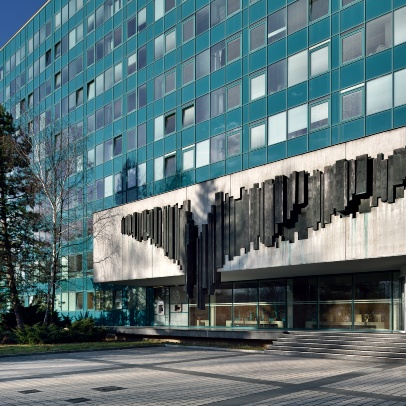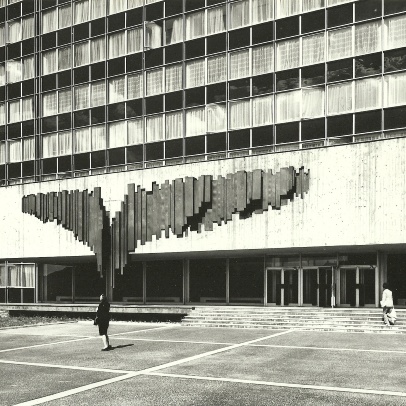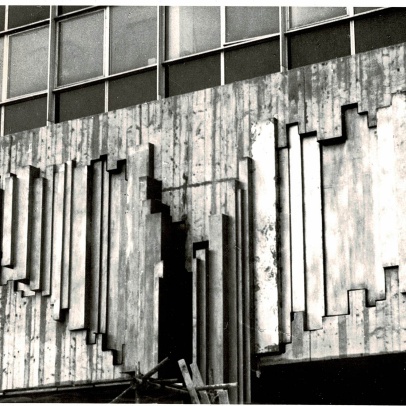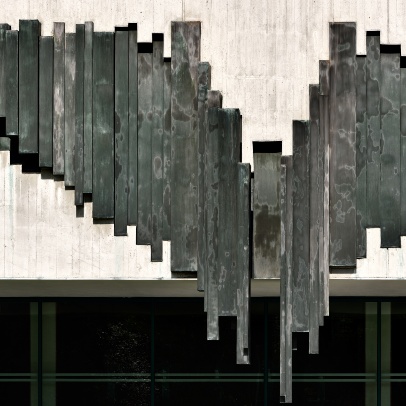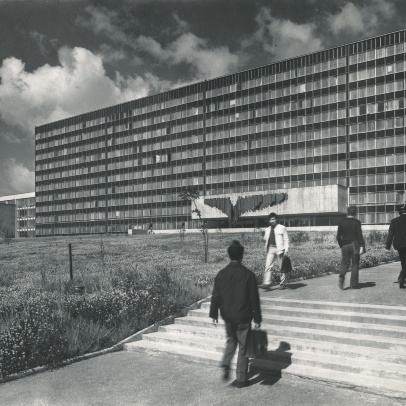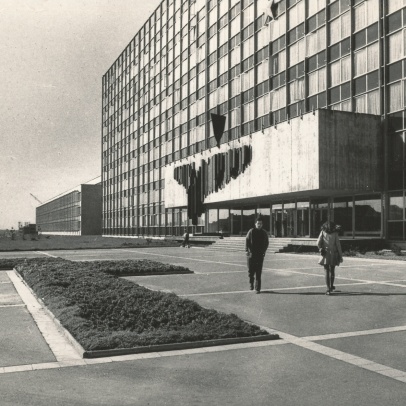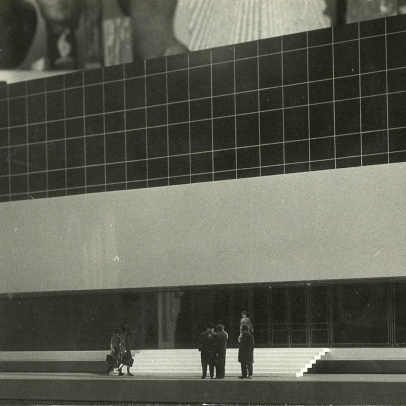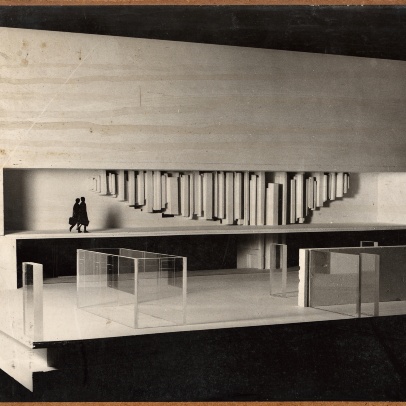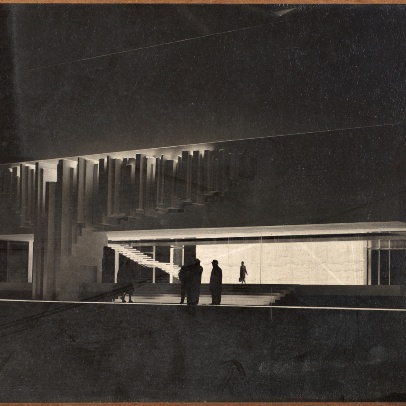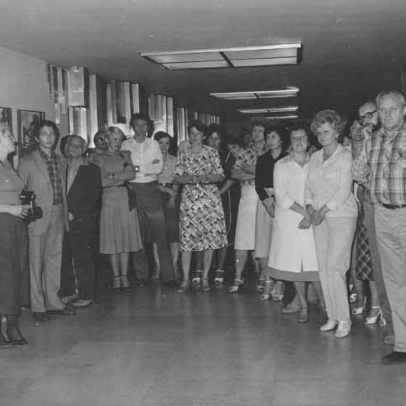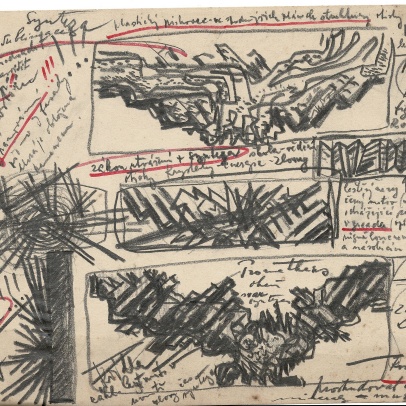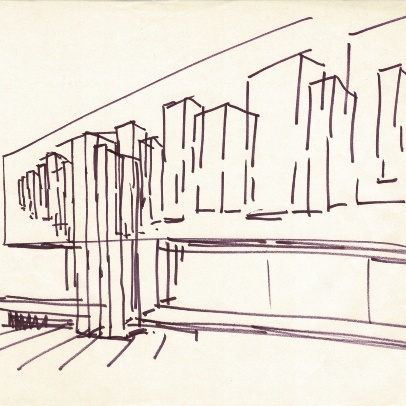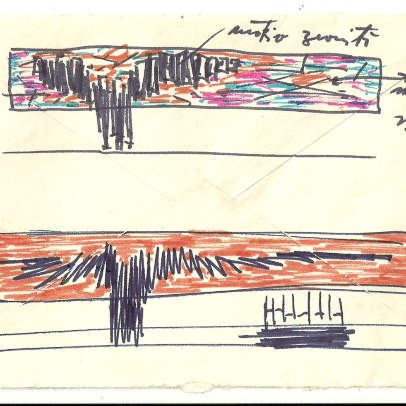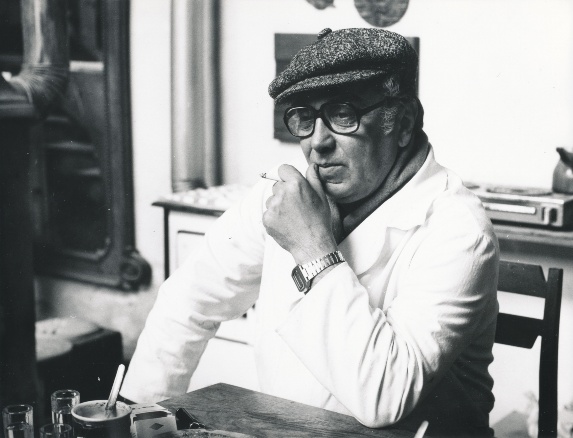Name: Prometheus/Expansion of Science, Technology and Civilization
Author: Vladislav Gajda (architectural cooperation Zdeněk Strnadel)
Dating: 1968–1973; 1974 takeover of the work, the interior part was unveiled again in 2019
Location: The front facade and gallery of the VŠB-TUO Rectorate and Faculties lobby
Execution: exterior and interior relief, copper plate, 400 X 1500 cm, inner part 250 cm high
VLADISLAV GAJDA’S VISION OF A MAGNIFICENT DEPICTION OF UNDERGROUND WEALTH
In the late 1960s, the Ostrava sculptor Vladislav Gajda (1925-2010) worked on a number of monumental reliefs and free sculptural installations. His position in the local art community, based on his previous achievements, is evidenced by the fact that in 1968, he was nominated as a regional representative in a nationwide competition for work of art for the first VŠB building in Ostrava-Poruba. It was a monumental artistic depiction of the entrance hall to the Rectorate and Faculties offices of the newly built university campus. The assignment was considered so important that even at the time of the strongest exercise of the influence of architects on the selection of authors of artworks for architecture, it was decided in the form of a competition, moreover with nationwide participation. Besides Gajda, some invited sculptors such as Rudolf Svoboda and Zdeněk Palcr, as well as the painters Čestmír Kafka and Eduard Ovčáček also submitted their proposals. Ovčáček’s and Svoboda‘s proposals were excluded as unsuitable in the first round; Kafka’, Palcr’ and Gajda’s commented proposals were shortlisted. However, only the latter two eventually participated.
Despite the social significance of the contract and the authority of the nationwide competition, the entire event was devalued due to several difficulties. Initially, some jury members failed to attend the first round of the competition. This happened again (though to a lesser extent) even in the latter round of the competition where, paradoxically, the main architect of the building Zdeněk Strnadel was absent. During the decision-making process, the jury first identified Vladislav Gajda’s proposal as the winner. But before signing all the reports, its members discovered a serious oversight – they overlooked an alternative proposal by Zdeněk Palcr, marked by the letter A. This proposal clearly seemed to be the best of all submitted proposals; therefore, the selection committee changed its decision announcing Mr. Palcr as the winner. However, the jury noted that as a cost-effective solution, the investor could also consider implementing Gajda’s proposal for the building’s interior. Although the proposals of the two sculptors involved were evaluated by the jury quite positively, and thus both proposals promised a good result, the competition was eventually rendered worthless by a subsequent initiative of the main architect, Strnadel (who had been absent in the latter round). He did not agree with Palcr’s proposal and, thanks to his then prime role as an architect in selecting the artwork, pushed through his own vision – the implementation of Vladislav Gajda’s proposal. The investor – Technical Administration for Construction of the Ministry of Education – under the pressure of the project architect, ordered the installation with Gajda, and Palcr was forced to give up his victory in a written statement. Despite all the respect to Gajda’s quality proposal, it is to be noted that Ostrava had lost one of the possibilities to enrich the public space with the work of art of a leading non-regional author.
The above-mentioned problems were still ongoing during 1970, so Gajda did not start submitting his modified proposals to the art committee until 1971. During the next three years, two or three works of art were created, which completed the entrance to the modern Rectorate building in a well-thought-out, interconnected concept. It is a copper relief of Prometheus, which, in fact, consists of two parts – the larger one in the exterior and the smaller in the interior of the building (giving the impression of a two-sided relief) and the sandstone relief Coal and Iron on the wall of the lobby across from the entrance to the building which, according to the committee, the author added to the concept later although it is obvious that he had already taken it into account in the first sketches in 1968.
The Prometheus relief is portrayed as wings with a drusy structure. It evokes deeper context and meaning – the ideas of the strength of the Titans, creation, intelligence, courage and strength to resist. The mythical Prometheus was a descendant of the Titans. Some myths attributed to Prometheus creation of man in the physical form of the gods. In the battle of the Titans and Olympians, Prometheus sided with Zeus and assisted in the birth of Pallas Athena from Zeus’ head, for which the goddess trained him in various arts, which Prometheus later passed on to humankind. However, he ended up being punished for the defiant theft of divine fire for humankind and was chained to the Caucasian rock where an eagle would peck his liver, which would repeatedly regrow. Nevertheless, the mythical hero was finally rescued and became a counsellor of gods. The dramatic story from ancient mythology is connected to the idea of the power of nature and the skills of man who draws energy from the depths of the earth. At the same time, the relief evokes the geological structure of the Ostrava region. However, at the turn of the 1960s and 70s, it was not possible to design and develop artwork in a mythological sense. Therefore, somewhat explicit, variant title Expansion of Science, Technology and Civilization appeared. This name strengthened the specific nature of the idea of coal mining, drawing energy for the welfare of people.
It is notable that Gajda’s work follows, with its theme and horizontal solution, upon the former reliefs that are, in the architectural and historical context, as important and similarly dimensioned as Gajda’s installation – The Birth of Coal (1940) created by Gajda’s teacher Jan Lauda (1898-1959) on a facade of the original building of the Emperor Ferdinand Northern Railway head office in Moravian Ostrava and Cosmic Age / Use of Atomic Power (1959-1963) created by Olomouc native Vladimír Navrátil (1907-1978). However, a formal aspect of the work fully corresponds to the constructive tendencies of the Czech sculpture of the 1960s. The sculptor used both the colour and plastic contrast of the metal processed as a relief, a neutral concrete strip of the main facade on which the relief is anchored, and also the turquoise-coloured facade with rhythmic window strips. The installation itself extends partially into the parterre, which is a vista opening into the lobby. Today, it gives an impression of a well-refined sculpture in the architecture of the Rectorate building facade.
The second part of the work, which Gajda ingeniously designed for the lobby of the new university, is a relief, which was intended to look like a permeation of the outdoor copper relief into the space of the hall or gallery above the staircase. Although the whole realization was accompanied by difficulties with the increase in prices for production using the noble material, at the end of 1973 (roughly a year after the exterior of the relief was installed) the interior part of the work was actually completed.
According to the designs and period photo documentation, the relief in the interior copied the shapes of the exterior relief. The material of the work in the interior was also copper sheet, but it was made (in contrast to the outdoor relief, made in the Brno workshops of the Center of Arts and Crafts) by the Ostrava woodworking cooperative Dyhor. The manufacturer allegedly warned the author that the work should be made of sheet metal at least 2 mm thick. However, the Technical Administration for Construction at the Ministry of Education was no longer willing to increase the already rising costs even more. Therefore, the relief was made of 1 mm thick sheet metal. As a result, it caused ripples on larger areas resulting in optical defects in the form of circular disks. At the beginning of the new millennium, the inner relief was covered with a plasterboard wall, which served as an exhibition area for short-term exhibitions. The inner part of the relief was gradually forgotten. However, its existence, as evidenced by archival research, was confirmed in June 2016 by a camera probe. The renewal of the unique artistic-architectural concept of the building was supported by the university management, and in November 2019, the internal relief was restored after the reconstruction of the entire space, including the original lighting of the space through roof skylights.
The designs with original sketches in the author’s personal archive seem to document the connection between the exterior relief, its interior part and the concept of the front wall in the interior from the very beginning of the project. Small-scale sketches represent mental variants of the exterior interconnecting with the interior. Even the photographs of the precisely developed model show all three parts of the work, at the same time providing us with a precise idea of their intended contexts and interconnections within the architectural design of the entrance of the building.
Both the theme and silhouette of the Prometheus are directly reflected in the sandstone The Coal and Iron relief on the ground floor of the front wall of the lobby. In two sentences in the corner of one of the sketches, the author expressed, in a nutshell, the contents of both parts of his artwork: “The basin symbolizes the unity of all the natural forces. Fire, the bearer of energy and life, is brought by Prometheus.”
